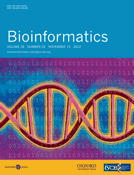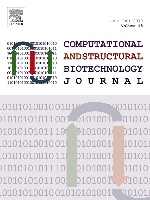
Frontiers in Bioinformatics
Scope & Guideline
Advancing the Future of Computational Biology
Introduction
Aims and Scopes
- Computational Genomics and Genetics:
The journal focuses on the application of computational methods to analyze genomic and genetic data, facilitating insights into genetic variation, disease mechanisms, and therapeutic targets. - Machine Learning and Artificial Intelligence:
There is a strong emphasis on the use of machine learning and AI techniques to improve predictions and analyses in bioinformatics, particularly in areas such as drug discovery, genomics, and protein interactions. - Multi-Omics Integration:
The journal promotes research that integrates multi-omics data (genomics, transcriptomics, proteomics, etc.) to provide a comprehensive understanding of biological systems and disease mechanisms. - Bioinformatics Tools and Software Development:
Frontiers in Bioinformatics publishes studies that develop new software tools and frameworks, enhancing the capabilities of researchers in analyzing biological data. - Data Visualization Techniques:
The journal emphasizes innovative visualization techniques for complex biological data, aiding in the interpretation and communication of research findings. - Structural Bioinformatics:
Research in this area focuses on the computational analysis of biological structures, including proteins and nucleic acids, to understand their functions and interactions.
Trending and Emerging
- Artificial Intelligence in Bioinformatics:
The integration of AI and machine learning into bioinformatics is rapidly growing, with applications in drug discovery, genomics, and predictive modeling, transforming how biological data is analyzed. - Single-Cell Omics:
Research focused on single-cell analysis is gaining traction, enabling detailed insights into cellular heterogeneity and the dynamics of cell populations in health and disease. - Network Medicine:
The concept of network medicine is emerging, emphasizing the need to understand diseases through the interactions of biological networks, which is crucial for developing targeted therapies. - Real-Time Data Processing and Analysis:
With the rise of technologies such as cloud computing and big data analytics, there is a growing emphasis on real-time processing of biological data to enable timely insights and interventions. - Precision Medicine and Personalized Genomics:
The journal is seeing an increased focus on precision medicine, utilizing bioinformatics to tailor treatments based on individual genetic profiles and disease mechanisms.
Declining or Waning
- Basic Sequence Alignment Techniques:
Traditional sequence alignment methods are becoming less prevalent as researchers increasingly adopt advanced algorithms and machine learning approaches that provide better accuracy and efficiency. - Single Omics Studies:
There is a noticeable shift away from studies focusing solely on single-omics data, as the integration of multi-omics approaches is now favored for a more holistic understanding of biological phenomena. - Static Biological Databases:
The reliance on static biological databases is waning in favor of dynamic, real-time data analysis and machine learning frameworks that allow for more adaptive and comprehensive insights. - Traditional Statistical Methods:
Conventional statistical methods are being overshadowed by machine learning and AI-driven methodologies, which offer more robust predictive capabilities for complex biological datasets. - Manual Data Annotation:
The practice of manual data annotation is decreasing as automated tools and machine learning techniques are developed to streamline and enhance the accuracy of data processing.
Similar Journals

Network Modeling and Analysis in Health Informatics and Bioinformatics
Elevating health informatics through advanced data analysis.Network Modeling and Analysis in Health Informatics and Bioinformatics, published by SPRINGER WIEN, stands as a vital resource in the interdisciplinary domains of health informatics and bioinformatics. With an ISSN of 2192-6662 and E-ISSN of 2192-6670, this journal aims to facilitate the dissemination of innovative research that intersects network modeling, data analysis, and health applications. The journal competes at a Q3 quartile level across multiple categories including Biomedical Engineering and Health Informatics, showcasing its growing influence within the academic community. As of 2023, it holds impressive Scopus rankings, including a 20th position in Urology, illustrating its significance in the field. Although not an open access publication, the journal is dedicated to providing cutting-edge insights from 2012 to 2024 and is poised to attract researchers, professionals, and students striving to push the boundaries of knowledge in health informatics and bioinformatics. This journal is not just a platform for sharing scholarly articles; it is a catalyst for advancing methodologies that enhance patient care and medical research.

BIOINFORMATICS
Transforming Biological Research Through Computational ExcellenceBIOINFORMATICS, published by Oxford University Press, is a leading journal in the realms of biochemistry, computational mathematics, and computer science, with a notable impact factor that underscores its significance in the field. Since its inception in 1985 and continuing through its expected convergence in 2024, the journal has maintained a prestigious reputation, proudly residing in the Q1 category across multiple disciplines, including molecular biology and statistics. With a Scopus ranking placing it within the top percentiles of its categories, BIOINFORMATICS serves as an essential platform for disseminating high-quality research that advances knowledge and innovation at the intersection of biology and computational sciences. This journal not only offers both subscription and open access options, ensuring wider availability of its cutting-edge research, but it has also become a crucial resource for researchers, professionals, and students aiming to stay at the forefront of bioinformatics and related fields. Explore the latest findings and trends that define the future of biological research through this esteemed publication, any inquiries regarding the journal can be directed to its offices located at Great Clarendon St, Oxford OX2 6DP, England.

Computational and Structural Biotechnology Journal
Connecting Computational Excellence with Structural Innovations in BiotechnologyComputational and Structural Biotechnology Journal is a premier open-access journal published by Elsevier, focusing on the intersection of computer science and molecular biology. Since its inception in 2012, the journal has established itself as a leading platform for innovative research, featuring groundbreaking studies in biochemistry, biophysics, biotechnology, and genetics. With a remarkable Q1 ranking in multiple categories, including Biochemistry and Genetics, it stands out for its high impact, evidenced by its strong Scopus ranking percentile scores. As a vital resource for researchers, professionals, and students, the journal aims to foster the dissemination of essential findings that leverage computational techniques to explore complex biological systems. In a rapidly evolving scientific landscape, Computational and Structural Biotechnology Journal serves as an indispensable resource for those looking to contribute and stay abreast of major advancements in the field.

NAR Genomics and Bioinformatics
Advancing the Frontiers of Genomics and BioinformaticsNAR Genomics and Bioinformatics, published by Oxford University Press, is a leading open-access journal that has been at the forefront of research in genomics and computational biology since its inception in 2019. With an impressive impact factor and a consistent ranking in the Q1 category across multiple fields—namely Applied Mathematics, Computer Science Applications, Genetics, Molecular Biology, and Structural Biology—this journal stands as an influential platform for disseminating innovative findings and methodologies. Researchers and professionals have the opportunity to engage with high-quality, peer-reviewed articles that reflect the latest advancements in both theoretical and applied aspects of bioinformatics. The journal's commitment to open access ensures that groundbreaking research is accessible to a global audience, fostering collaboration and knowledge sharing within the scientific community. The country of publication is the United Kingdom, with a dedicated editorial team striving to maintain the highest standards of academic excellence.

Bioinformatics Advances
Empowering Researchers with Cutting-edge Bioinformatics SolutionsBioinformatics Advances, published by Oxford University Press, is an esteemed academic journal that serves as a vital platform for the dissemination of innovative research in the rapidly evolving fields of bioinformatics and computational biology. With a promising E-ISSN of 2635-0041, this journal has made significant strides since its inception in 2021, achieving a commendable Q1 ranking in both the Computer Science Applications and Genetics categories, alongside respectable Q2 rankings in Molecular Biology and Structural Biology as of 2023. Though currently not an open-access publication, its critical insights cater to an audience keen on advancing knowledge and technology in genomic studies and data analytics. The journal emphasizes high-quality research and aims to facilitate the integration of computational techniques within biological sciences, making it an essential resource for researchers, professionals, and students alike who seek to stay at the forefront of bioinformatics advancements.

PLoS Computational Biology
Connecting Minds in Computational BiologyPLoS Computational Biology is a premier open-access journal published by the Public Library of Science, committed to advancing the understanding of complex biological data through computational approaches. Since its inception in 2005, the journal has made significant strides in the fields of Cellular and Molecular Neuroscience, Computational Theory and Mathematics, Ecology, Genetics, and Molecular Biology, achieving a notable Q1 ranking in various categories as of 2023. With an exceptional impact factor and an esteemed ranking—such as Rank #23/176 in Computational Theory and Mathematics—PLoS Computational Biology provides a vital platform for researchers, professionals, and students to disseminate their cutting-edge findings and insights. The journal's open-access model ensures that high-quality research is freely accessible worldwide, fostering collaboration and innovation across disciplines. Located in San Francisco, CA, it serves as a hub for the global scientific community, making it an indispensable resource for anyone at the forefront of computational biology and its diverse applications.

Briefings in Functional Genomics
Connecting Research and Discovery in GenomicsBriefings in Functional Genomics, published by Oxford University Press, serves as a crucial academic resource in the fields of biochemistry, genetics, and molecular biology. With an ISSN of 2041-2649 and an E-ISSN of 2041-2657, this esteemed journal explores innovative research and developments in functional genomics, with a commitment to advancing our understanding of genetic processes and their implications in health and disease. Ranking in the Q2 quartile for both Biochemistry and Genetics, and occupying a prominent Q1 status in the domain of interdisciplinary Medicine, the journal is positioned as a leading platform for researchers seeking to disseminate their findings to a global audience. Although it does not currently offer open access options, its accessibility through institutional subscriptions and its esteemed impact factor underscore its importance in the research community. Covering converging topics from 2010 to 2024, Briefings in Functional Genomics not only keeps pace with the rapidly evolving landscape of genomics but also stimulates collaboration and dialogue among scientists and industry professionals alike, making it an indispensable tool for researchers, practitioners, and students eager to engage with cutting-edge genomic science.

Algorithms for Molecular Biology
Empowering researchers with open access to transformative methodologies.Algorithms for Molecular Biology, published by BMC, is a premier Open Access journal dedicated to advancing the field of molecular biology through innovative computational methods. Since its inception in 2006, the journal has provided a vital platform for researchers to share their findings and methodologies, covering a diverse range of topics at the intersection of applied mathematics, computational theory, and molecular biology. With a notable impact factor reflected in its Scopus ranks, including a Q2 classification in both applied mathematics and computational theory, as well as Q3 in molecular and structural biology, the journal plays an essential role in this rapidly evolving discipline. The wide accessibility of articles published under the Open Access model ensures that research findings reach a global audience, fostering collaboration and innovation amongst scientists and professionals alike. As we look towards converging years from 2006 to 2024, Algorithms for Molecular Biology continues to uphold the highest standards of scientific integrity and excellence, reinforcing its status as a key resource for those engaged in the profound complexities of molecular biology.

GENOMICS PROTEOMICS & BIOINFORMATICS
Pioneering innovations in genomics and proteomics since 2003.GENOMICS PROTEOMICS & BIOINFORMATICS, published by Elsevier, stands at the forefront of cutting-edge research in the fields of genomics, proteomics, and bioinformatics. This esteemed journal, with an impact factor reflecting its significant influence, has embraced an Open Access model since its inception in 2003, ensuring that knowledge is freely accessible to a global community of researchers, professionals, and students. Based in China, it has been recognized for its exemplary contributions, achieving Q1 quartile rankings in major categories such as Biochemistry, Computational Mathematics, Genetics, and Molecular Biology as of 2023. Moreover, its commendable Scopus rankings position it among the top journals in its fields, with outstanding percentile performances that highlight its scholarly impact. As it continues to converge from 2003 to 2024, the journal aims to foster innovation and collaboration, making it an essential platform for disseminating vital insights and advancements in molecular life sciences.

Journal of Bioinformatics and Computational Biology
Empowering Research Through Computational InsightsThe Journal of Bioinformatics and Computational Biology, published by WORLD SCIENTIFIC PUBL CO PTE LTD, serves as a significant platform for disseminating innovative research in the dynamic fields of bioinformatics and computational biology. With an ISSN of 0219-7200 and an E-ISSN of 1757-6334, this journal facilitates the exchange of ideas and advancements from its inception in 2003 and continues to be pivotal through 2024. Despite its classification in the lower quartiles—Q4 in Biochemistry and Q4 in Molecular Biology, along with Q3 in Computer Science Applications—the journal remains a valuable resource for researchers and students alike, as it emphasizes interdisciplinary approaches essential for tackling complex biological problems through computational methods. Located in Singapore, the journal encourages submissions of high-quality, peer-reviewed articles that offer insights into computational techniques that empower biological research. Although this journal does not offer open access options, its contributions to research are increasingly recognized across various academic platforms. As the field evolves rapidly, this journal continues to attract a growing readership, making it an essential reference point for anyone interested in the intersection of biology and computer science.